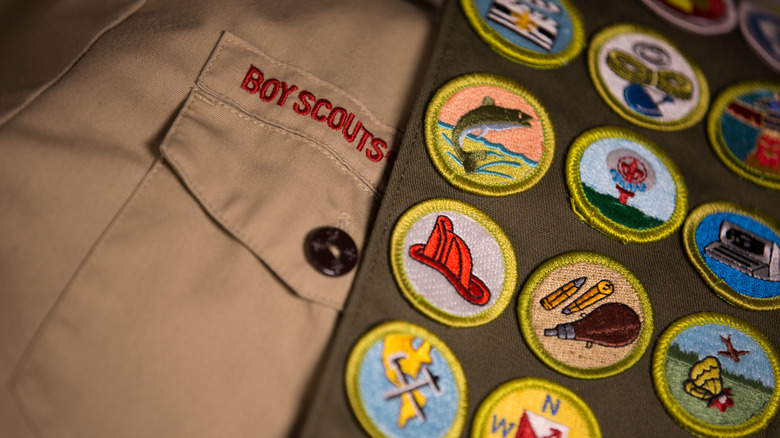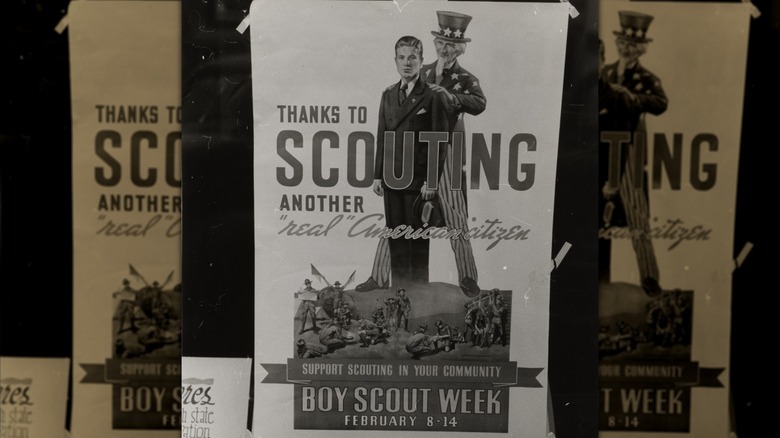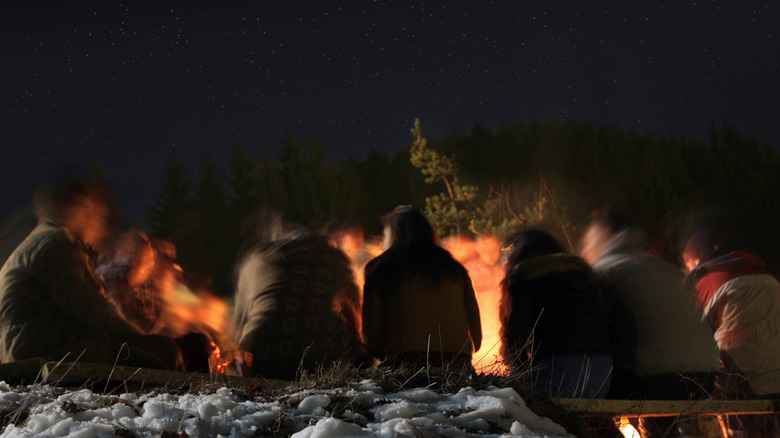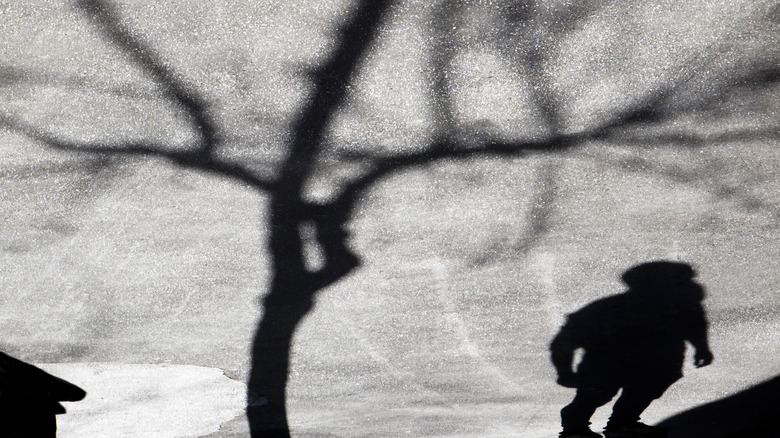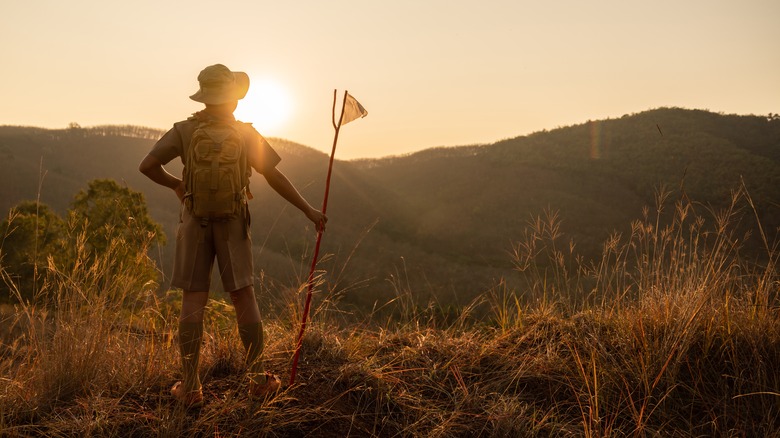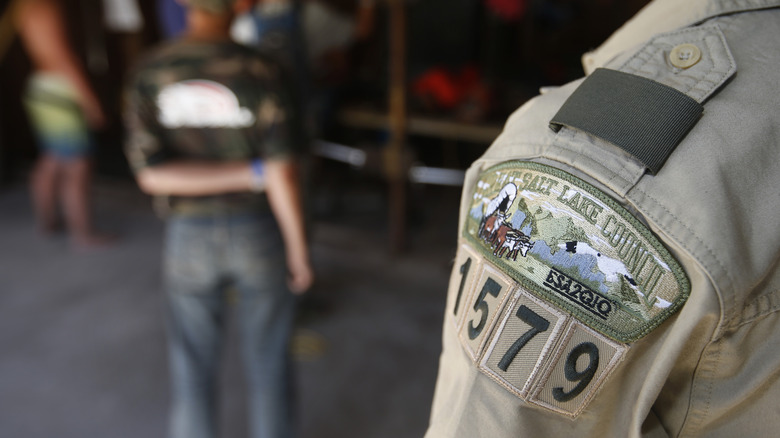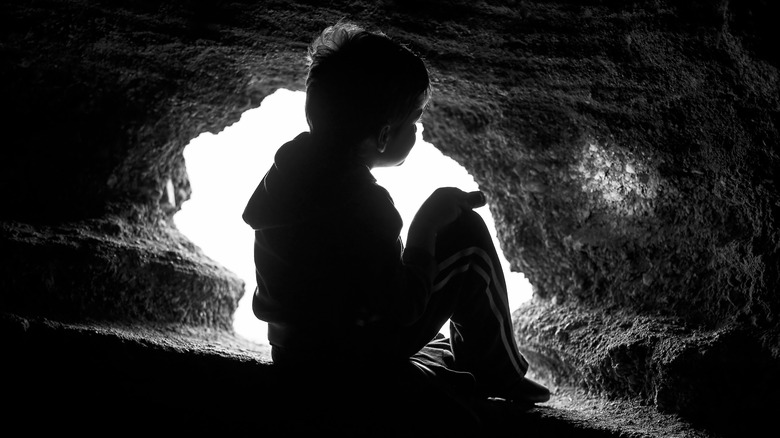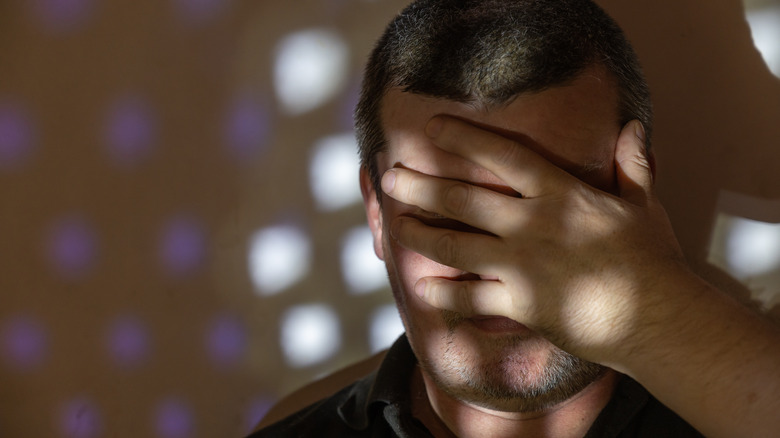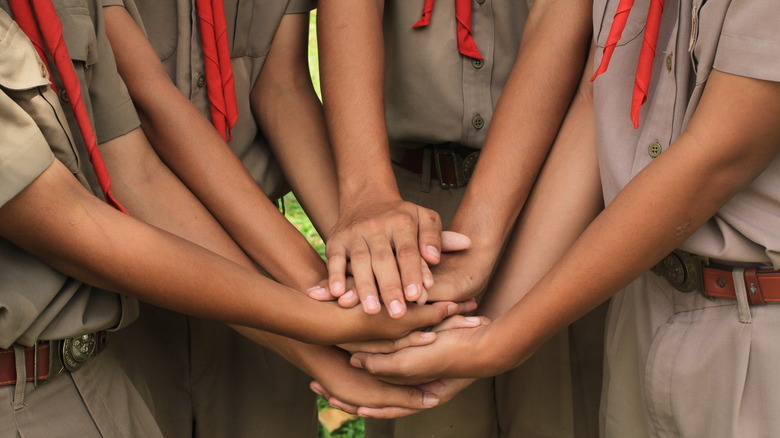Disturbing Details About The Boy Scouts Of America's Sexual Abuse Scandal
Back in 2020, the Boy Scouts of America were in the headlines for a terrible reason: They were facing so many claims from former Scouts who had been sexually abused and assaulted that the organization filed bankruptcy. At the time, the Scouts' vice president of communications, Effie Delimarkos, issued a statement (via NPR) explaining the move: "We did so with the dual objectives to help compensate victims for what they experienced... But we also did so so that we can continue the mission of scouting." In July of 2021, the organization announced it had settled with more than 60,000 claimants for $850 million. Then the scandal got even bigger.
By 2023, more than 80,000 victims had come forward, including the 18,000 members of an organization called the Coalition of Abused Scouts for Justice. They issued a statement saying that they were grateful to see "some justice to tens of thousands of survivors, ... many of whom have been waiting decades for this day to arrive." The settlement amount upheld by the courts was a whopping $2.46 billion.
Was it finally shutting the door on a sordid chapter in the long, complicated history of the Boy Scouts? No, says The Washington Post. The paper noted some terrible things, including the lack of a comprehensive investigation into the organization and the accusations, and the fact that — still, in 2023 — only a single state's attorney general's office had launched a formal investigation (Michigan). In other words, it's possible that the staggering numbers are just the beginning.
One man's court case turned on the spotlight
The Boy Scouts of America have been sued a lot, and an investigation by Oregon Live turned up at least 60 cases that had been brought against them between the mid-1980s and 2010. But according to Patrick Boyle, author of "Scout's Honor: Sexual Abuse in America's Most Trusted Institution," "the Boy Scouts of America had managed to keep these cases largely underwater nationally." That is, until Kerry Lewis.
Lewis went to court with some shocking allegations: Not only had he been sexually abused by a Scout leader when he was 11 and 12 years old, but Lewis testified that his abuser had been reported to scouting authorities and was allowed to continue to work with boys. Lewis — who made history by allowing his name to be made public along with his allegations — was awarded an initial $1.4 million and then a further $18.5 million in punitive damages.
Fundamental to Lewis' case was a series of documents that the court allowed the jury to see in a landmark ruling. The 1,200-odd files — which were shown to the jury only, and were part of a much larger set of documents that remained confidential – were related to internal investigations into accusations of pedophilia in Scout troops across the nation. On the heels of Lewis' case was another lawsuit to open those files to the public, and in 2012, the Oregon Supreme Court ordered the unsealing of the so-called "perversion files."
Evidence goes back a long, long time
The Boy Scouts of America (BSA) have been pressured to allow public access to the long-confidential "perversion files," a series of documents that includes information on volunteers and Scout leaders accused of sexual assault, as well as the names of thousands of victims. Back in 2012, 1,200 of those files — dating from the 1960s to the 1980s — were ordered to be made public by the Oregon Supreme Court. In 2019, attorneys were pushing to have still more files unlocked.
One of those lawyers was Jeff Anderson, who summarized the problem for NBC News: "...the Boy Scouts of America have never alerted communities that this Scout leader, this coach, this teacher is known to be a child molester. That is the real alarming fact that needs to be mentioned today. It's systematic and across the country." The numbers were staggering, with the files said to contain the names of 7,819 offenders, dating back to 1944.
According to the Los Angeles Times, the BSA's records of people barred from volunteering actually go back to 1919. Janet Warren, a professor with the University of Virginia, pointed out to NPR that at the time, it was a revolutionary idea. Unfortunately, the execution wasn't great, and attorneys working for the release of the files pointed out (via The New York Times) that there's no way of determining how many files were created, how many names were really there, and how many were lost. They also noted that historically, most troops didn't know the files existed.
Files failed to keep accused predators away from children
Boy Scout files failed to protect scouts in a pretty big way that's perhaps best summed up by a letter written by an outraged father in 1981. It was included in the files, and he'd written it after he had reported a Scout leader for abusing his sons. The family saw the abuser again at a Boy Scout Jamboree, and the father wrote (via The New York Times), "Your assurances that Joe was out of scouting and would have no further contact with scouting have just become meaningless."
In fact, when the Los Angeles Times did a deep dive into the files, they found that they revealed a trend of repeat offenders who were kicked out of one troop then reappeared in another. How? Falsified information, clerical errors, and overlooked names and files. In some instances, it was all perfectly above-board, as far as the Scouts were concerned.
Offenders weren't reported to outside authorities, and were often put on probation or just removed from their troop, sometimes with dire consequences. The LA Times cited the story of one man removed from his position as Scoutmaster in 1970. By the time he was convicted of assaulting a Scout and sentenced to 100 years in prison in 1989, he'd worked with two other troops and confessed to assaulting more than 100 boys. Even in Kerry Lewis's landmark case, his legal team was able to show that the Scoutmaster who had abused him had previously confessed to the Scouts that he had molested boys, but remained a part of scouting.
Survivors have spoken about not only sex abuse, but trafficking
In 2019, a massive lawsuit was filed in Pennsylvania courts by a team of lawyers who were working together to resurrect sexual assault cases that had been buried. Included were claims that some boys were initially groomed in preparation for future sexual assaults. Attorney Tim Kosnoff described the extent of abuse (via the BBC): "This will sound hyperbolic, but it's sex trafficking. It's the largest pedophile ring on earth."
Some abuse survivors have come forward to tell stories of how they were not just sexually abused by Scout leaders, but how they were also the victims of sex trafficking. Ron Hunter spoke with The Guardian in 2023 and told them about how he initially found sanctuary with the Boy Scouts.
He was 12 years old the first time he was assaulted, and not only did the assault continue, but Hunter recounted how Carlos Acevedo lured him into scouting, then ultimately forced him to work an area of Manhattan's 42nd Street, reporting clients and agreed-upon fees via a series of hand signals before leaving with them. It wasn't until he was 17 that he met a man who helped him out of that life, away from Acevedo, and into school. Hunter says that it took him a long time to come to terms with the fact that his savior had initially purchased his services when he was 13 years old. Once known by the street name "Angel," Hunter has since written a book about his experiences, called "Angel Finally Found His Wings."
Parents who have tried to get help haven't gotten satisfactory responses
Some of the people who have come forward with allegations of sexual abuse have also spoken about how they were targeted because they were vulnerable children. Ron Hunter, for example, has said that he was approached while living in a New York orphanage. Frank Spinelli told NPR that he grew up in the 1970s, and with his father working two jobs, his mother thought he could use a male role model. That was New York City police officer and Scoutmaster Bill Fox, who used sleepovers at his house as a gateway to abuse.
But what about the parents who did try to do something about it? That story, too, was often filled with heartache. Time spoke to one mother who reached out to the Boy Scouts through their helpline, which was promoted as a way to report misconduct. She said she reached a volunteer who was working from home, who told her that she and her teenage son would have to go through the police and file an official report. That, she said, was after calling the director of the Boy Scout camp where the abuse — at the hands of counselors — took place. The response? "Boys will be boys."
There has been overlap with the Catholic Church sex abuse scandal
A 2023 op-ed piece in The Washington Post pointed out that hundreds of the claims of abuse filed with the Boy Scouts took place within Catholic troops. That brought up questions of how much each organization knew: It was unclear just how the groups were working together to alert each other of potential abusers in their ranks.
Because, there has been overlap. In several states, priests accused of sexual abuse also served as Scout leaders, including at least four people in Pennsylvania and 12 in Maryland. The Post asks, "Did Catholic officials never tell the Scouts? Or were Scouts part of a coverup?"
Take the case of Michael O'Hara. He was added to the Boy Scouts' "perversion files" in 1966, along with documents that detailed an incident where he attempted to molest a boy who then reported him. Included are letters from O'Hara himself, inquiring why he'd been turned down for a position with the Scouts. His occupation — "Teacher in Catholic School" — is clearly recorded, and he was finally arrested in 1987 when one of his former victims agreed to wear a wire for the FBI and meet with his abuser. Jim Clemente got a recorded confession and O'Hara was connected to around 200 victims, but since the statute of limitations had run out, he was sentenced to a year in jail on a child pornography charge. It was noted that even though the Boy Scouts had an entire file on O'Hara, he still spent years teaching at schools throughout the Archdiocese of New York.
The Mormon church was accused of aiding in cover-ups
In 2018, the Church of Jesus Christ of Latter-Day Saints announced they were ending a century-long partnership with the Boy Scouts of America. The reason, they stated, was that they were unrolling their own Scout-like program that would be established under the umbrella of the Mormon church. Fast-forward to 2020, and the church found itself being served seven lawsuits accusing it of being complicit in the cover-up of decades of abuse within the Boy Scouts.
The lawsuits all made similar allegations, saying that when victims told church authorities about being sexually abused, they were told that an investigation would be conducted by the church. Instead, bishops allegedly buried the accusations, and secular authorities were never notified. CBS News reported that a spokesman for the church, Sam Penrod, said there was "zero tolerance for abuse of any kind" and acknowledged that the accusations should be investigated, but denied that the church had access to the Boy Scouts' so-called "perversion files," saying they were only granted access when the files were made public.
In 2021, the church agreed to contribute $250 million to settle claims against the Scouts. At the time, another church spokesman said in a statement (via Deseret News), "The Church of Jesus Christ of Latter-day Saints condemns abuse of any kind. We express our love and concern for those who have experienced abuse through scouting or any other circumstance."
There's a history of victims being pressured to stay silent
Abuse within the Boy Scouts has been going on for decades, and now-adult survivors are coming forward. That includes Stuart Lord, who was assaulted by someone who was not only a Boy Scout assistant troop leader, but a high school English teacher in Yonkers, New York. He spoke with RAINN about the questions he had growing up: "I was a child who was taught to trust adults. Surely people in my community would notice that something was wrong? I trusted that someone who cared about me would intervene."
The pressure to stay silent has had dire consequences: Depending on the state, it means many cases are never heard because the statute of limitations is up. Some of the Boy Scouts' most vocal critics are quick to point out that their close relationship with major religious organizations and long-standing ban on openly gay members goes a long way toward instilling feelings of shame: Those who are abused are made to feel it's their fault.
Those who do come forward have been made examples of. Peter Zuckerman was an Idaho journalist who, in 1997, ran a story on former Scout Adam Steed and the man he said molested him, Brad Stowell. The Intercept told a terrible story of Steed being shunned by his entire community, even as Zuckerman was also condemned, harassed, and threatened to the point where he moved away. Stowell, who confessed to assaulting 24 boys, was sentenced to a mere 150 days in jail and had his records partially sealed.
It can take a long, long time for victims to see justice done
The Boy Scouts' "perversion files" names nearly 8,000 alleged predators, and in some cases, it's taken abuse outside of the Scouts to put them behind bars. Take the case of Floyd David Slusher. The 70-year-old former Boy Scout troop leader was handed a 36-year sentence in 2023, for downloading child pornography. But he'd been on the radar of the Boy Scouts since the 1970s, when he was first accused of molesting boys in his troop in Germany. He was moved to Boulder, Colorado, and was accused (and convicted) several more times before being given his 36-year sentence (via CBS News).
Similarly, a former Boy Scouts chaplain named James Glawson was reported to authorities in 2019. He had been employed in a group home in Rhode Island when he was accused of molesting a developmentally disabled boy, but he also admitted to abusing others while in his role as a Scout leader.
And it's been happening for a long time. In 1993, the Greensboro News & Record reported that Samuel Max Dubois Jr. was facing charges of sexually assaulting two boys. He'd already served prison terms in Alaska and California on the same charges, and his was one of the names mentioned by the Los Angeles Times in their deep dive into the Boy Scouts' "perversion files." They found the testimony of a 10-year-old Boy Scout who, in 1972, wrote a graphic account of an alleged rape. Dubois, they say, was kicked out of the Scout troop but not formally charged.
Adults aren't the only perpetrators
When Time did a 2019 deep dive into accusations of sexual assault in the Boy Scouts of America, they spoke with multiple men who were now speaking out about the unthinkable traumas they had suffered as children and teenagers. Some had tracked down their assailants and confronted them. One, Edward Pittson, was abused when he was 12. Even though 58 years had passed, he explained that he still hoped to see justice done: "He's still alive. I would love this guy to answer for what he's done. It's not too late."
And here's the thing: Not all assaults were perpetrated by adults. When they interviewed a mother trying to get help for her 14-year-old son, she revealed that he had been assaulted by youth counselors. And that's just the tip of the iceberg.
Michael Johnson spent more than a decade as the director of youth protection for Scouts BSA, and in 2021, he wrote a letter to Congress. He condemned the Scouts for setting up what he said was essentially the perfect place for predators, particularly young ones, and shared a terrifying statistic: "More than 50% of the reported sexual abuse incidents into Scouts BSA are perpetrated by youth in the program." And youth aren't screened in the same way that adults are, even though the program often puts children and teens — with a wide age gap — together.
Some experts say it's still not good enough
With the tens of thousands of lawsuits that the Boy Scouts of America has found themselves facing, surely it's gotten safer, right? According to Michael Johnson, former director of youth protection for Scouts BSA, founder of Plano, Texas's Child Advocacy Center, and former law enforcement officer, the answer is a definite "no."
In a 2021 letter to Congress, Johnson condemned the lack of reforms within the organization. He said that although he had been able to implement a number of changes — including training programs and establishing a system for reporting abuse — there was so much more that needed to be done that he wrote: "In my professional opinion, the truth is clear: No child is safe in Scouts BSA programs. The institution, as it stands today, continues to be a HIGH-RISK organization for child sexual abuse, due to the accessibility and opportunity the program presents to a range of sex offenders."
Johnson cited a laundry list of failings, including not having proper screening procedures in place to vet employees and volunteers; what he called "inadequate criminal background screening"; and their continued use of a "72-hour rule," which basically meant that, at the time of Johnson's letter, anyone could accompany scouts on events — including overnight camping trips — without having gone through any screening process, as long as they were staying with the troop for less than three days. His suggestions for making scouting safer included 12 actionable steps that needed to be taken, and until they were, Johnson warned that abuse would continue.
If you or someone you know may be the victim of sexual assault or child abuse, contact the relevant resources below:
- Visit the Rape, Abuse & Incest National Network website or contact RAINN's National Helpline at 1-800-656-HOPE (4673).
- Call the Childhelp National Child Abuse Hotline at 1-800-4-A-Child (1-800-422-4453) or contact their live chat services.
